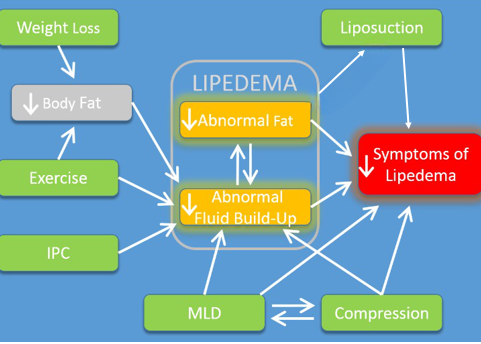
Exploring treatment options for lipedema
Dr. Srinagesh Vadrevu
November 20, 2023

Lipedema is a condition characterized by the abnormal accumulation of fat in the legs and sometimes in the arms.
Several treatment options are available to manage lipedema, and the choice of treatment depends on the severity of your condition and your individual needs. It’s essential to work closely with healthcare professionals who are knowledgeable about lipedema to create a personalized treatment plan.
Here are some common treatment options for lipedema:
- Conservative Management:
- Compression Therapy: Wearing compression garments, such as stockings or sleeves, can help reduce swelling and discomfort in the affected limbs.
- Manual Lymphatic Drainage (MLD): MLD is a specialized massage technique that can help improve lymphatic flow and reduce swelling.
- Complete Decongestive Therapy (CDT): CDT includes a combination of techniques, including MLD, compression therapy, exercise, and skin care, to manage symptoms.
- Dietary Changes: Adopting a healthy, anti-inflammatory diet can support overall health and may help manage some symptoms of lipedema.
- Exercise: Engaging in regular, low-impact exercise and strength training can improve muscle tone, support joint health, and help manage symptoms.
- Liposuction:
- Liposuction is a surgical option that can remove excess fat from the affected areas. Water-assisted liposuction (WAL) and tumescent liposuction are techniques commonly used for lipedema.
- This surgical approach is considered one of the most effective treatments for reducing the volume of fat in the affected limbs and improving symptoms.
- Consult with a board-certified surgeon experienced in lipedema surgery to discuss the risks and benefits.
- Medications:
- Some medications may be prescribed to help manage pain and inflammation associated with lipedema, though they may offer only partial relief.
- Physical Therapy:
- Working with a physical therapist who specializes in lymphedema and lipedema can help you learn exercises and techniques to manage symptoms.
- Lymphatic Surgery:
- In some cases, lymphatic surgeries may be considered to address lymphatic issues that can exacerbate lipedema.
- Psychological Support:
- Coping with a chronic condition like lipedema can be emotionally challenging. Seeking psychological support or counselling can help you manage the emotional aspects of the condition.
- Research and Clinical Trials:
- Stay informed about ongoing research and clinical trials related to lipedema treatment. Participating in clinical trials can provide access to innovative treatment options.
- Lipedema
- Lymphatic Surgery
- Physical Therapy
- Liposuction
- Management of lipedema
- Proper research
Conclusion
It’s important to note that there is no one-size-fits-all approach to treating lipedema, and the most effective treatment plan will depend on the individual and the specific characteristics of the condition. Be sure to work closely with healthcare professionals who are experienced in managing lipedema to develop a treatment plan tailored to your needs and goals. Additionally, stay informed about the latest advancements in lipedema treatment, as research in this field is ongoing.
To connect with us click on the button below
To know more fill in the details below:
Recent Posts
Have Any Question?
Lipedema is a condition that causes excess fat to accumulate in the lower part of the body.
- +919515106591
- srinageshlipedema@gmail.com



